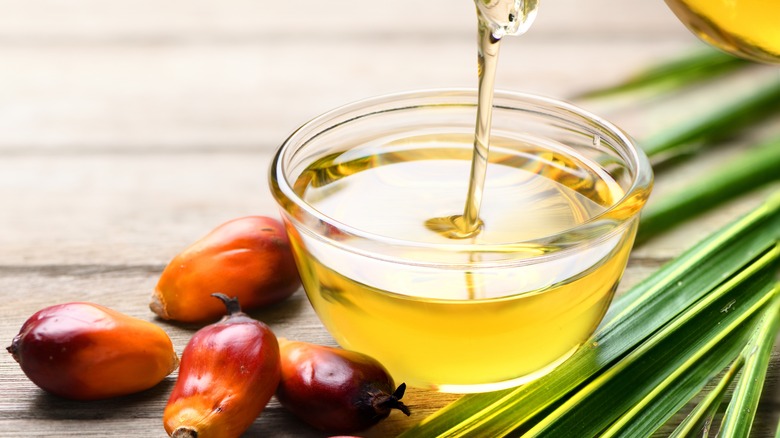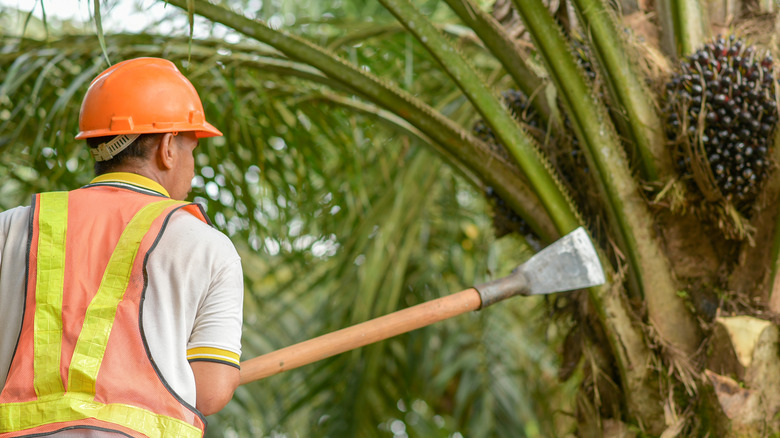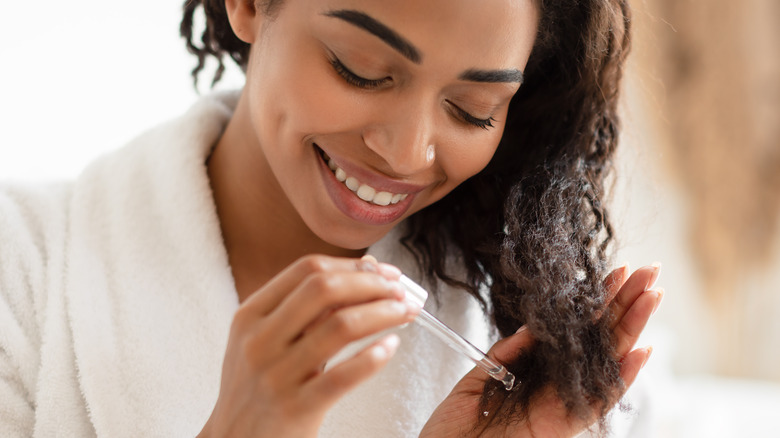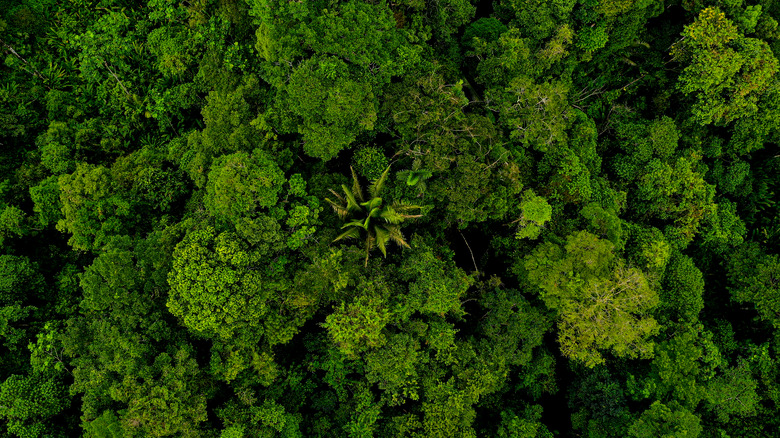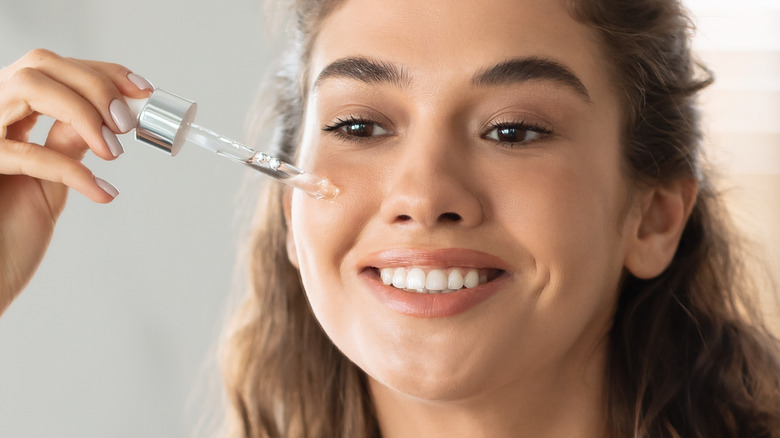The Prevalence Of Palm Oil In Beauty Products Is A Mystery No Longer
Cultivated in biodiverse tropical forests in Indonesia and Malaysia, palm oils are among the most sought-after oils in the world. Palm oil is present in a plethora of products we use in day-to-day activities, including cooking oil, animal feed, detergent, shampoo, biofuel, and cosmetics. With its low saturated fat content, high melting point, and high smoke point, palm oil is immensely versatile and resilient. Plus, palm oil is relatively cheap compared to other vegetable oils. Over the past five decades, demand for palm oil has increased sharply.
According to a 2020 article published in Our World In Data, the world was only churning out two million tonnes of palm oil in 1970. Fast forward to 2018, 71 million tonnes of palm oil were produced. If you wonder how palm oil consumption has soared so much, look through the ingredients list on the back of your cosmetics products. Chances are, you'll find at least one personal care item in your arsenal that contains this magic ingredient. Truth be told, the beauty industry is no less hooked on palm oil than the food and beverage industry or the oil industry. Here's why palm oil has been so widely adopted in beauty products.
What is palm oil?
Most palm trees are grown in Malaysia and Indonesia, home to 85% of the world's palm oil supply, according to World Wide Fund for Nature. Palm oil is extracted from the fruit of palm trees, from which two types of oil can be produced: crude palm oil, which comes from squeezing the fleshy fruit, and palm kernel oil, which comes from crushing the kernel of the fruit. Palm oil derivatives are identified by chemical names such as cetyl palmitate, stearic acid and palmityl alcohol or cetyl alcohol, per Malaysiakini.
Boasting high fatty acid content, palm oils are often used to produce surfactants, emulsifiers, and emollients. Palm oil and its derivatives, which have various advantages including skin hydration, foaming, and softening, are present in 70% of cosmetic products, per Malaysian Palm Oil Council. Topically, palm oil can be added to cleansers, moisturizers, and lotions to balance out the astringent qualities of the products while softening and nourishing the skin. For instance, cetyl alcohol, an ingredient obtained from palm oil, is a common thickening and emulsifying substance in lipsticks, moisturizers, face creams, and other cosmetics to help preserve the consistency and smooth texture of the formula, per Chemical Safety Facts. Aside from its inherent moisturizing qualities, palm oil is also a well-tolerated and relatively inexpensive ingredient, which is why it's the most used oil for the creation of base ingredients in skincare products.
Benefits of palm oil on the skin
Like all ingredients generated from plants, palm oil is made up of a variety of different fats, vitamins, and minerals that have a positive impact on the skin. Palm oil, according to a study published in PLOS One, contains fatty acids such as palmitic acid, oleic acid, linoleic acid, and stearic acid, which act as cleansing and moisturizing agents as well as texture enhancers in skincare products. Thanks to its dense concentration of fatty acids, palm oil does a wonderful job in retaining moisture in the skin and creating a smoother skin surface, according to The Derm Review.
Certain palm oil species, such as red palm trees, are also high in alpha- and beta-carotene (antioxidants) and vitamin E, according to a research article published in the journal Food and Nutrition Bulletin. These compounds play a significant role in reducing the damage of UV radiation on the skin, preventing age spots, and maintaining skin health. Vitamin K — a vitamin loaded with collagen-stimulating and wound-healing components — is also vastly present in palm oil, according to Lybrate. "By improving the elasticity of blood vessels and overall vascular health, vitamin K can help with a handful of leading aging factors, including the appearance of stretch marks, varicose veins, bruising, undereye puffiness, dark circles, and other conditions that have a vascular component," dermatologist Dr. Sejal Shah tells Real Simple.
Benefits of palm oil on the hair
Not only is palm oil good for skin, it can also promote a healthy scalp and stimulate healthy hair growth. "Red palm oil is an antioxidant, rich in vitamin E that benefits the hair by promoting cell growth of the hair follicles, resulting in stronger hair. The carotenes that give red palm oil its color can also help with the growth and division of cells that help prevent hair from becoming brittle and weak," dermatologist Stacy Chimento tells Byrdie. The oil also contains stearic acid, which conditions and protects the hair shaft, and myristic acid, which is useful for cleansing the hair and scalp. Thanks to its emollient properties, red palm oil is highly effective in moisturizing your hair and your scalp as well as minimizing tangles and breakages.
For those with oily or acne-prone skin on the scalp, red palm oil might cause your scalp to trap dirt, lead to clogged pores, and cause a breakout, trichologist Lacy Fields tells Byrdie. To nourish your hair with red palm oil, you can use it as a hair mask before your hair wash routine or wear it like a leave-in conditioner three times per week. The rule of thumb is to avoid over-saturating your hair with the formula lest it weighs your hair down and makes it look greasy.
Controversies surrounding palm oil
Palm oil use has a tremendous environmental impact. To accommodate the rising demands for palm oil, many rain forests have been cleared to make the way for mega palm tree plantations, according to Down To Earth.
Burning is a common method for getting rid of vegetation in both oil palm fields and wild forests. As a result of burning, forest fires release smoke and carbon dioxide into the atmosphere, which contaminates the air and exacerbates global warming. Orangutans, elephants, and rhinoceroses are among the endangered species whose natural habitats are threatened by widespread deforestation brought on by the manufacturing of palm oil. According to Esri Australia, for every metric ton of palm oil produced, a palm oil mill generates 2.5 tons of liquid waste, contaminating freshwater resources and harming biodiversity and human health. In other words, palm oil is a significant contributor to the destruction of some of the biodiverse forests on the planet. Not to mention, the production of palm oil has also been connected to child labor and worker exploitation, per the U.S. Department of Labor.
Although many organizations, including cosmetics companies, are collaborating with local people to develop sustainable practices of producing and sourcing palm oil, many environmentalists are calling for a boycott of palm oil once and for all. With the prevalence of palm oil in modern products, however, it is not that simple.
Alternatives to palm oil
If you think the cons of palm oil outweigh its pros, you can take steps to reduce your reliance on this popular ingredient when it comes to skincare or hair care. One way to do that is to avoid using products that contain palm oils. Organic babassu oil, a vegetable oil produced from the seeds of the babassu palm, is a more environmentally friendly alternative to palm oil, per Essential Wholesale & Labs. Babassu oil has been used for centuries to treat wounds, inflammation, and some skin disorders. Babassu oil, which is high in antioxidants, can protect the skin from UV exposure and help minimize damage caused by damaging free radicals, according to MedicineNet.
Organic mango and shea butters, as well as organic jojoba oil and sunflower oil, are also excellent substitutes for palm oils when it comes to nourishing your skin and hair without amplifying your carbon footprints. When you're shopping for cosmetics, pay attention to the products that specify the names of the oils included, such as 100% coconut oil, canola oil, or olive oil. But here's the pickle. Palm oil is in a plethora of derivatives with a multitude of alternative names, ranging from stearyl alcohol to laurel myristate to octyl stearate (according to Palm Oil Investigations), so avoiding it completely can be challenge.
